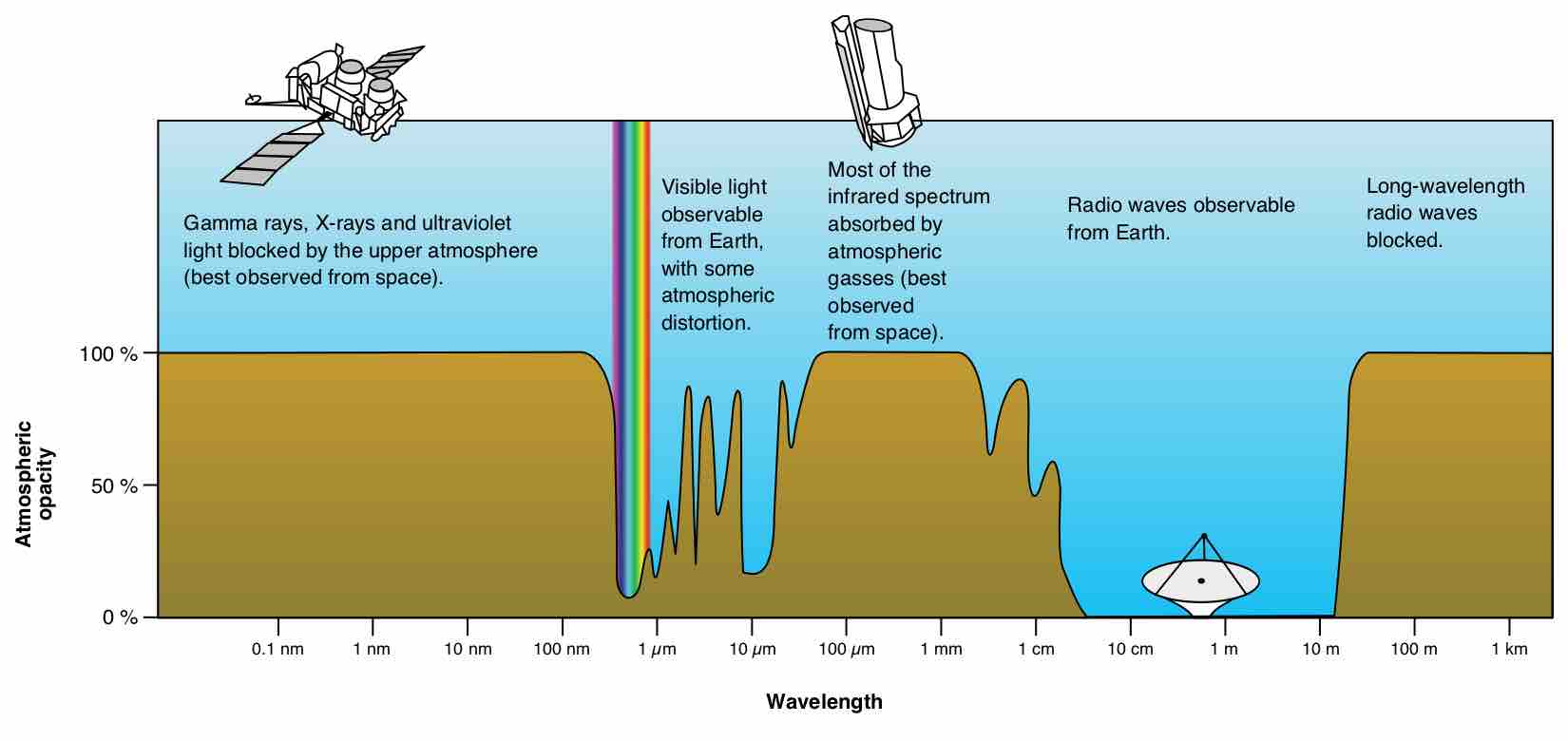Visible Light
Visible light, as called the visible spectrum, is the portion of the electromagnetic spectrum that is visible to (can be detected by) the human eye. Electromagnetic radiation in this range of wavelengths is often simply referred to as "light". A typical human eye will respond to wavelengths from about 390 to 750 nm (0.39 to 0.75 µm). In terms of frequency, this corresponds to a band in the vicinity of 400–790 THz. A light-adapted eye generally has its maximum sensitivity at around 555 nm (540 THz), in the green region of the optical spectrum. The spectrum does not, however, contain all the colors that the human eyes and brain can distinguish. Unsaturated colors such as pink, or purple variations such as magenta, are absent, for example, because they can be made only by a mix of multiple wavelengths.
Electromagnetic Spectrum
The electromagnetic spectrum, showing the major categories of electromagnetic waves. The range of frequencies and wavelengths is remarkable. The dividing line between some categories is distinct, whereas other categories overlap. Microwaves encompass the high frequency portion of the radio section of the EM spectrum.
Visible light is produced by vibrations and rotations of atoms and molecules, as well as by electronic transitions within atoms and molecules. The receivers or detectors of light largely utilize electronic transitions. We say the atoms and molecules are excited when they absorb and relax when they emit through electronic transitions.

Visible Spectrum
A small part of the electromagnetic spectrum that includes its visible components. The divisions between infrared, visible, and ultraviolet are not perfectly distinct, nor are those between the seven rainbow colors.
The figure above shows this part of the spectrum, together with the colors associated with particular pure wavelengths. Red light has the lowest frequencies and longest wavelengths, while violet has the highest frequencies and shortest wavelengths. Blackbody radiation from the Sun peaks in the visible part of the spectrum but is more intense in the red than in the violet, making the Sun yellowish in appearance.
Colors that can be produced by visible light of a narrow band of wavelengths (monochromaticlight) are called pure spectral colors. Quantitatively, the regions of the visible spectrum encompassing each spectral color can be delineated roughly as:
- red - 620 to 750 nm (400-484 THz)
Note that each color can come in many shades, since the spectrum is continuous. The human eye is insensitive to electromagnetic radiation outside this range. By definition any images presented with data recorded from wavelengths other than those in the visible part of the spectrum (such as IR images of humans or animals or astronomical X-ray images) are necessarily in false color.
Visible Light and Earth's Atmosphere
Visible wavelengths pass through the "optical window", the region of the electromagnetic spectrum which allows wavelengths to pass largely unattenuated through the Earth's atmosphere (see opacity plot in. An example of this phenomenon is that clean air scatters blue light more than red wavelengths, and so the midday sky appears blue.

Atmospheric Transmittance
This is a plot of Earth's atmospheric transmittance (or opacity) to various wavelengths of electromagnetic radiation. Most UV wavelengths are absorbed by oxygen and ozone in Earth's atmosphere. Observations of astronomical UV sources must be done from space.
The optical window is also called the visible window because it overlaps the human visible response spectrum. This is not coincidental as humanity's ancestors evolved vision that could make use of the most plentiful wavelengths of light.The near infrared (NIR) window lies just out of the human vision, as well as the Medium Wavelength IR (MWIR) window and the Long Wavelength or Far Infrared (LWIR or FIR) window though other animals may experience them.
A consequence of the existence of the optical window in Earth's atmosphere is the relatively balmy temperature conditions on Earth's surface. The Sun's luminosity function peaks in the visible range and light in that range is able to travel to the surface of the planet unattenuated due to the optical window. This allows visible light to heat the surface. The surface of the planet then emits energy primarily in infrared wavelengths, which has much greater difficulty escaping (and thus causing the planet to cool) due to the opacity of the atmosphere in the infrared. Earth's surface would be much cooler without this effect.
Photosynthesis
Plants, like animals, have evolved to utilize and respond to parts of the electromagnetic spectrum they are embedded in. Plants (and many bacteria) convert the light energy captured from the Sun into chemical energy that can be used to fuel the organism's activities. In plants, algae, and cyanobacteria, photosynthesis uses carbon dioxide and water, releasing oxygen as a waste product. Photosynthesis is vital for all aerobic life on Earth (such as humans and animals). The portion of the EM spectrum used by photosynthesic organisms is called the photosynthetically active region (PAR) and corresponds to solar radiation between 400 and 700 nm, substantially overlapping with the range of human vision. This is again not coincidental; the light in this range is the most plentiful to organisms on the surface of Earth because the Sun emits about half of its luminosity in this wavelength range and it is allowed to pass freely through the optical windows in Earth's atmosphere.